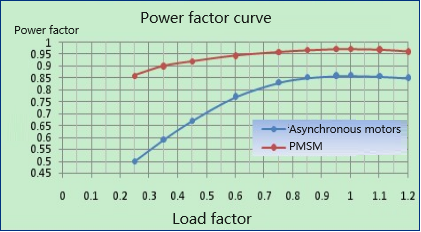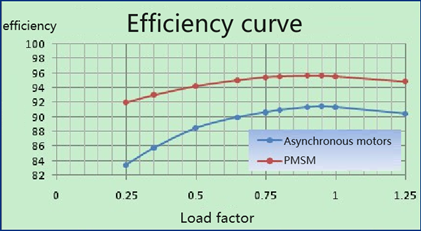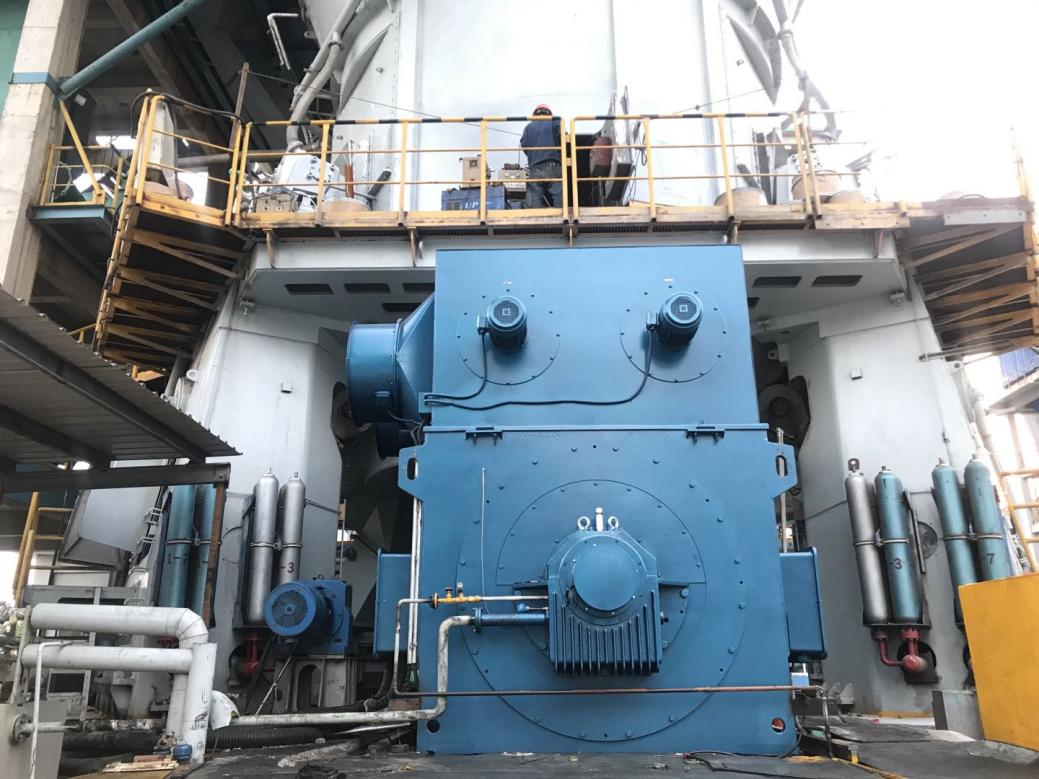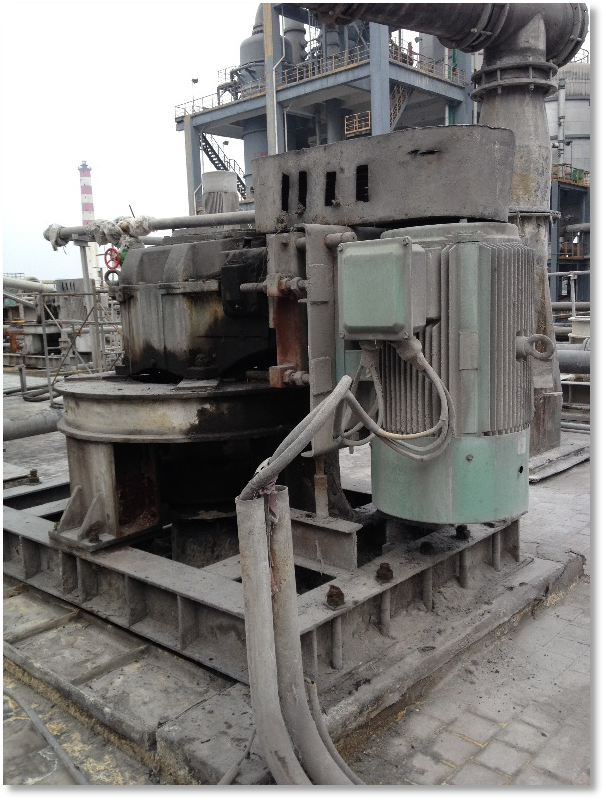Compared with asynchronous motors, permanent magnet synchronous motors have the advantages of high power factor, high efficiency, measurable rotor parameters, large air gap between stator and rotor, good control performance, small size, light weight, simple structure, high torque/inertia ratio, etc. They have been increasingly widely used in the fields of petroleum, chemical industry, textile, mining, CNC machine tools, robots, etc., and are developing towards high power (high speed, high torque), high functionality and miniaturization.
Permanent magnet synchronous motors are composed of stators and rotors. The stator is the same as asynchronous motors, consisting of three-phase windings and stator cores. Pre-magnetized (magnetized) permanent magnets are installed on the rotor, and a magnetic field can be established in the surrounding space without external energy, which simplifies the motor structure and saves energy. This article explains the comprehensive benefits of promoting permanent magnet synchronous motors based on the characteristics of permanent magnet synchronous motors.
1. Outstanding advantages of permanent magnet synchronous motor
(1) Since the rotor is made of permanent magnets, the magnetic flux density is high, no excitation current is required, and excitation loss is eliminated. Compared with asynchronous motors, the excitation current of the stator winding and the copper and iron losses of the rotor are reduced, and the reactive current is greatly reduced. Since the stator and rotor magnetic potentials are synchronized, the rotor core has no fundamental wave iron loss, so the efficiency (related to active power) and power factor (related to reactive power) are higher than those of asynchronous motors. Permanent magnet synchronous motors are generally designed to have high power factor and efficiency even when running under light load.
When the load rate of ordinary asynchronous motors is less than 50%, their operating efficiency and power factor drop significantly. When the load rate of Mingteng permanent magnet synchronous motors is 25%-120%, their operating efficiency and power factor do not change much, and the operating efficiency is >90%, and the power factor is >0.85. The energy-saving effect is significant under light load, variable load and full load.
(2) Permanent magnet synchronous motors have relatively rigid mechanical properties and are more resistant to motor torque disturbances caused by load changes. The rotor core of a permanent magnet synchronous motor can be made into a hollow structure to reduce the rotor inertia, and the starting and braking time are much faster than that of an asynchronous motor. The high torque/inertia ratio makes permanent magnet synchronous motors more suitable for operation under fast response conditions than asynchronous motors.
(3) The size of permanent magnet synchronous motors is significantly smaller than that of asynchronous motors, and their weight is also relatively lighter. With the same heat dissipation conditions and insulation materials, the power density of permanent magnet synchronous motors is more than twice that of three-phase asynchronous motors.
(4) The rotor structure is greatly simplified, which is easy to maintain and improves the stability of operation.
Since three-phase asynchronous motors need to be designed with a higher power factor, the air gap between the stator and rotor must be made very small. At the same time, the uniformity of the air gap is also crucial to the safe operation and vibration noise of the motor. Therefore, the requirements of the shape and position tolerance and assembly concentricity of the asynchronous motor are relatively strict, and the freedom of the bearing clearance selection is relatively small. Asynchronous motors with larger bases usually use oil bath lubrication bearings, which must be filled with lubricating oil within the specified working time. Oil leakage or untimely filling of the oil cavity will accelerate the failure of the bearing. In the maintenance of three-phase asynchronous motors, the maintenance of bearings accounts for a large proportion. In addition, due to the existence of induced current in the rotor of the three-phase asynchronous motor, the problem of electrical corrosion of the bearing has also been concerned by many researchers in recent years.
Permanent magnet synchronous motors do not have such problems. Due to the large air gap of the permanent magnet synchronous motor, the above problems caused by the small air gap of the asynchronous motor are not obvious in the synchronous motor. At the same time, the bearings of the permanent magnet synchronous motor use grease-lubricated bearings with dust covers. The bearings have been sealed with an appropriate amount of high-quality grease when leaving the factory. The service life of the permanent magnet synchronous motor bearings is much higher than that of the asynchronous motor.
In order to prevent the shaft current from corroding the bearing, Anhui Mingteng permanent magnet motor adopts an insulation design for the bearing assembly at the tail end, which can achieve the effect of insulating the bearing, and the cost is much lower than that of insulating the bearing. To ensure the normal service life of the motor bearing, the rotor part of all permanent magnet synchronous direct drive motors of Anhui Mingteng has a special support structure, and the on-site replacement of bearings is the same as that of asynchronous motors. Later bearing replacement and maintenance can save logistics costs, save maintenance time, and better guarantee the user’s production reliability.
2. Typical applications of permanent magnet synchronous motors replacing asynchronous motors
2.1 Variable frequency speed regulation high-voltage ultra-high-efficiency three-phase permanent magnet synchronous motor for vertical mill in cement industry
Take the ultra-high-efficiency permanent magnet synchronous motor TYPKK1000-6 5300kW 10kV replacement asynchronous motor transformation as an example. This product is the first domestic high-voltage permanent magnet motor above 5MW for vertical mill transformation provided by Anhui Mingteng for a building materials company in 2021. Compared with the original asynchronous motor system, the power saving rate reaches 8%, and the production increase can reach 10%. The average load rate is 80%, the efficiency of the permanent magnet motor is 97.9%, and the annual power saving cost is: (18.7097 million yuan ÷ 0.92) × 8% = 1.6269 million yuan; the power saving cost in 15 years is: (18.7097 million yuan ÷ 0.92) × 8% × 15 years = 24.4040 million yuan; the replacement investment is recovered in 15 months, and the return on investment is obtained for 14 consecutive years.
Anhui Mingteng provided a complete set of vertical mill transformation equipment for a building materials company in Shandong (TYPKK1000-6 5300kW 10kV)
2.2 Low-voltage self-starting ultra-high-efficiency three-phase permanent magnet synchronous motor for chemical industry mixers
Take the ultra-high-efficiency permanent magnet synchronous motor TYCX315L1-4 160kW 380V replacement asynchronous motor transformation as an example. This product was provided by Anhui Mingteng in 2015 for the transformation of mixer and crusher motors in the chemical industry. TYCX315L1-4 160kW 380V is suitable for mixer working conditions. By calculating the energy consumption per ton per unit time, the user calculated that the 160kw permanent magnet synchronous motor saves 11.5% more electricity than the original asynchronous motor with the same power. After nine years of actual use, users are very satisfied with the power saving rate, temperature rise, noise, current and other indicators of Mingteng permanent magnet synchronous motor in actual operation.
Anhui Mingteng provided mixer modification support for a chemical company in Guizhou (TYCX315L1-4 160kW 380V)
3. Issues that users care about
3.1 Motor life The life of the entire motor depends on the life of the bearing. The motor housing adopts IP54 protection level, which can be increased to IP65 under special circumstances, meeting the use requirements of most dusty and humid environments. Under the condition of ensuring good coaxiality of the motor shaft extension installation and appropriate radial load of the shaft, the minimum service life of the motor bearing is more than 20,000 hours. The second is the life of the cooling fan, which is longer than that of the capacitor-operated motor. When running for a long time in a dusty and humid environment, it is necessary to regularly remove the sticky substances attached to the fan to prevent the fan from burning due to overload.
3.2 Failure and protection of permanent magnet materials
The importance of permanent magnet materials to permanent magnet motors is self-evident, and their cost accounts for more than 1/4 of the material cost of the entire motor. Anhui Mingteng permanent magnet motor rotor permanent magnet materials use high magnetic energy product and high intrinsic coercivity sintered NdFeB, and conventional grades include N38SH, N38UH, N40UH, N42UH, etc. The company has designed professional tooling and guide fixtures for magnetic steel assembly, and qualitatively analyzed the polarity of the assembled magnetic steel by reasonable means, so that the relative magnetic flux value of each slot magnetic steel is close, which ensures the symmetry of the magnetic circuit and the quality of magnetic steel assembly.
The current permanent magnet materials can run for a long time under the maximum allowable temperature rise of the motor winding, and the natural demagnetization rate of the magnetic steel is not higher than 1‰. Conventional permanent magnet materials require the surface coating to withstand a salt spray test of more than 24 hours. For environments with severe oxidative corrosion, users need to contact the manufacturer to select permanent magnet materials with higher protection technology.
4. How to select permanent magnet motor to replace asynchronous motor
4.1 Determine the load type
Different loads such as ball mills, water pumps, and fans have different performance requirements for motors, so the load type is very important for design or selection.
4.2 Determine the load state of the motor in normal operation
Is the motor running continuously at full load or light load? Or is it sometimes heavy load and sometimes light load, and how long is the light and heavy load change cycle?
4.3 Determine the impact of other load states on the motor
There are many special cases of the load state of the on-site motor. For example, the belt conveyor load needs to bear radial force, and the motor may need to be adjusted from ball bearings to roller bearings; if there is a lot of dust or oil, we need to improve the protection level of the motor.
4.4 Ambient temperature
The on-site ambient temperature is what we need to focus on during the motor selection process. Our conventional motors are designed for an ambient temperature of 0~40 ℃ or below, but we often encounter situations where the ambient temperature is higher than 40 ℃. At this time, we need to choose a motor with higher power or a specially designed motor.
4.5 On-site installation method, motor installation dimensions
On-site installation method, motor installation dimensions, on-site installation method and installation dimensions are also data that must be obtained, either the original motor appearance drawing, or the installation interface dimensions, foundation dimensions and motor placement space location. If there are space restrictions on site, it may be necessary to change the motor cooling method, the location of the motor lead box, etc.
4.6 Other environmental factors
Many other environmental factors have an impact on motor selection, such as dust or oil pollution affecting the motor protection level; for example, in marine environments or environments with high pH, the motor needs to be designed for corrosion protection; in environments with high vibration and high altitude, there are different design considerations.
4.7 Investigation of original asynchronous motor parameters and operating conditions
(1) Nameplate data: rated voltage, rated speed, rated current, rated power factor, efficiency, model and other parameters
(2) Installation method: obtain the original motor appearance drawing, on-site installation pictures, etc.
(3) Actual operating parameters of the original motor: current, power, power factor, temperature, etc.
Conclusion
Permanent magnet synchronous motors are particularly suitable for heavy-start and light-running applications. The promotion and use of permanent magnet synchronous motors has positive economic and social benefits and is of great significance to energy conservation and emission reduction. In terms of reliability and stability, permanent magnet synchronous motors also have valuable advantages. The selection of high-efficiency permanent magnet synchronous motors is a one-time investment with long-term benefits.
Anhui Mingteng Permanent Magnet Electromechanical Equipment Co., Ltd. (https://www.mingtengmotor.com/)has been focusing on the research, development, production and sales of ultra-high-efficiency permanent magnet synchronous motors for 17 years. Its products cover a full range of high-voltage, low-voltage, constant frequency, variable frequency, conventional, explosion-proof, direct drive, electric rollers, and all-in-one machines, aiming to provide more efficient driving force for industrial equipment.
Anhui Mingteng’s permanent magnet motors have the same external installation dimensions as the currently widely used asynchronous motors, and can fully replace asynchronous motors. In addition, there is a professional technical team to design and provide customers with free transformation solutions. If you have the need to transform asynchronous motors, please do not hesitate to contact us, and we will serve you wholeheartedly!
Post time: Aug-23-2024




